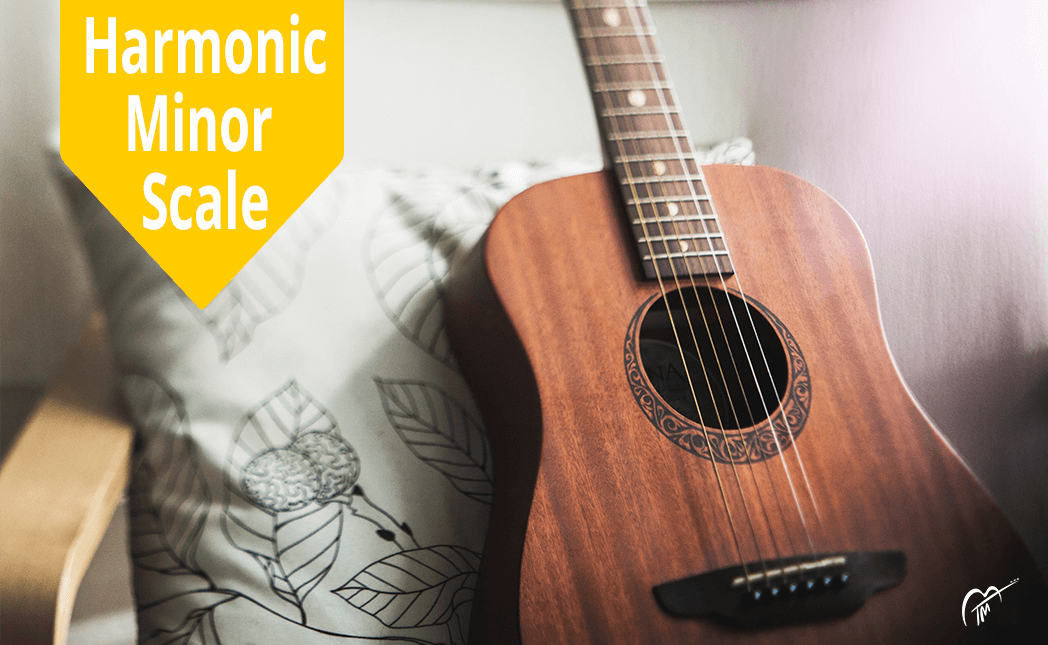
One of the scales I like to use a lot in my improvisation is the harmonic minor scale. It's very similar to a regular minor scale (also called natural minor). There is only one note difference.
The harmonic minor scale is very similar to the basic minor scale. The harmonic minor scale has all the same notes with the exception of the 7th note. The 7th note in the harmonic minor scale is one half step higher than in the minor scale.
For example… Let's take the A minor scale. The notes are A, B, C, D, E, F and G. In terms of intervals it looks like this:
Some Harmonic Minor Theory
The harmonic minor scale is very similar to the basic minor scale. The harmonic minor scale has all the same notes with the exception of the 7th note. The 7th note in the harmonic minor scale is one half step higher than in the minor scale.
For example… Let's take the A minor scale. The notes are A, B, C, D, E, F and G. In terms of intervals it looks like this:

Now let's look at the a harmonic minor scale. The notes are A, B, C, D, E, F and G#. Again the difference is the G# instead of a G note. That makes only one half step away from the octave A in the harmonic minor scale instead of one full step in the minor scale.
The interesting sound comes from that half step as well as the distance of 1 1/2 steps (also called a minor 3rd interval) between the F and the G#. This is what creates that exotic sound.
Again, with the intervals it looks like this:

Playing The Harmonic Minor Scale
In this lesson I'm going to teach you the harmonic minor scale in the key of A in the open position. Of course there are many other positions... And it will be helpful to learn the movable versions as well.
I like to teach the open position first in part because it's a good sound to improvise with in the Spanish or Latin guitar style. Also I learned the movable positions first, and I discovered later that it caused me some problems not knowing the open position of the scales like this one. I want to make sure you don't make that same mistake.
Here's the basic fingering for the harmonic minor scale in the key of A in the open position:

Practicing The Harmonic Minor Scale
Here’s some basic steps to help you practice and learn guitar scales in general as well as the harmonic minor scale.
1. First learn the basic fingering. Go slow and try to do it correctly.
2. Then practice slowly going up and down the scale using your own imaginary tempo (in your head… or tap your foot). Try to play the notes evenly. You may have to go very slow at first.
3. Now practice the scale with a metronome. Again go as slow as you need to to get it right. You can pick up speed a little at a time, but spread this out over several days.
4. Time to have some fun. Play the scale along with the backing tracks that you can download for free (see below). Start with the slow version and work your way up to the faster version. If you have to just play a few notes at a time. Then try adding a few notes until you can do the whole scale up and down.
5. Take it up a notch by creating your own unique short phrases and starting the process of improvising along with the backing track. Don't be shy… Go crazy! Just keep at it a little each day and you'll make improvement.
6. When you're ready make a video and post it on YouTube of you improvising with a backing track. You can set it to unlisted if you don’t want the public to see it. Post a link to the video in the comments below and let others hear what you’re doing. This gives you something to work for as well as helps inspire everyone.
Tell Us What You Think - Please Comment Below!
We would love to hear your comments and questions. What specific things are you struggling with while learning guitar?

thank you . I always I joy the lessons you give. i’m 77 years old and just now learning classical and flamenco guitar.
Great to have you here Robert. I’m glad you’re enjoying the lessons.
Hello! By the way, I´m 74 y old.
Tomas! When do you visit again Spain?
Abraço
António
Hi Antonio… hopefully soon. I’ve promised to take my sweetheart to Barcelona. -Tomas